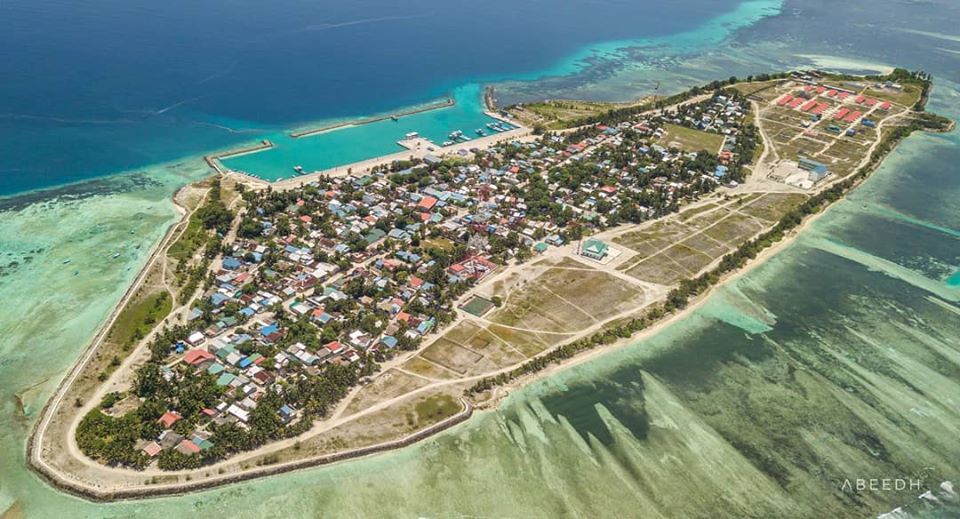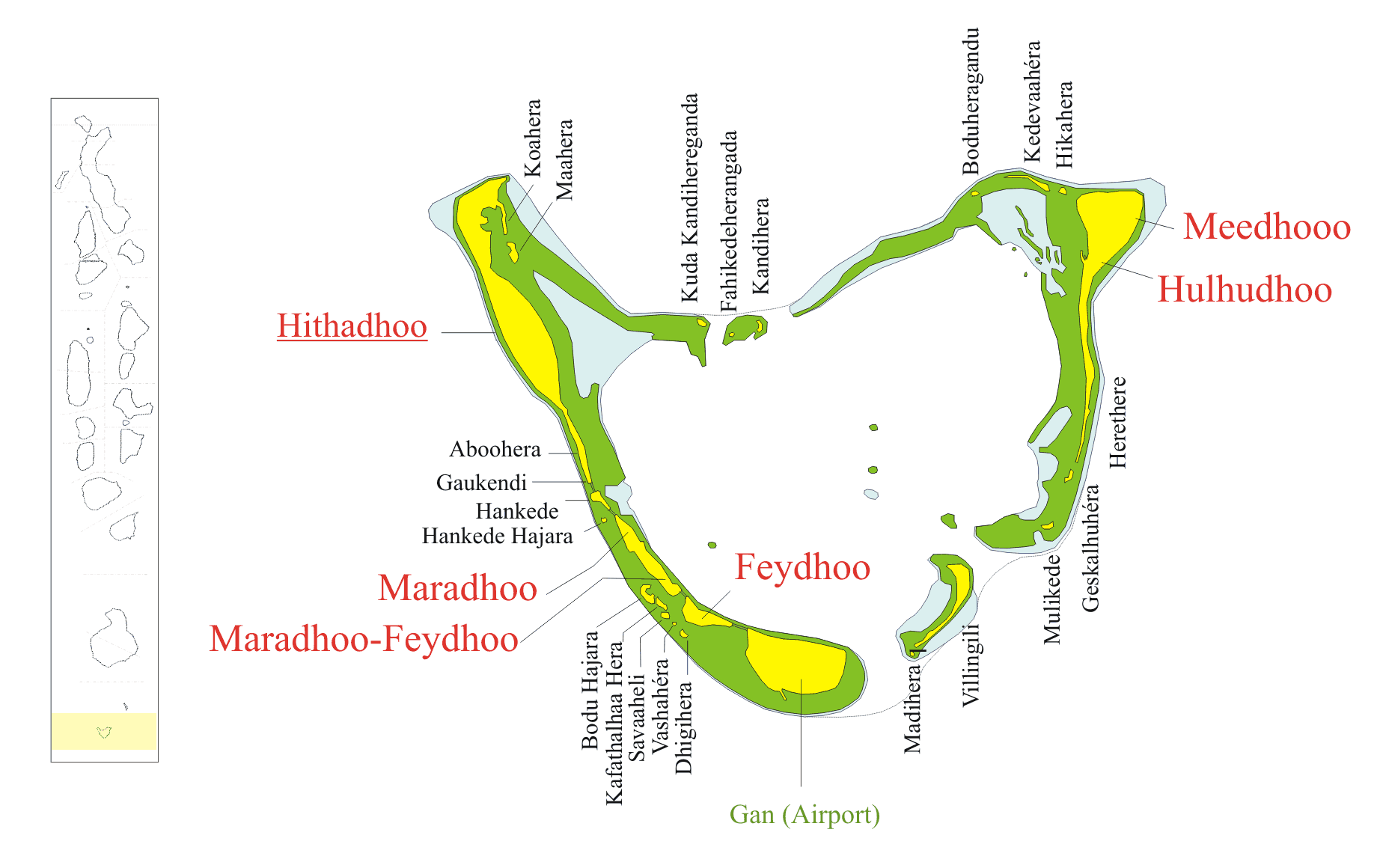|
Gaddhoo
Gadhdhoo (Dhivehi: ގައްދޫ), is the second most populated island in Gaafu Dhaalu Atoll. It has its own dialect of Dhivehi which is considerably different from northern and mid-Maldivian speech. History Secession of the Suvadive Islands In January 1959, the three southern atolls: Huvadhu, Fuvahmulah and Addu, were involved in setting up the breakaway United Suvadive Republic which survived in Addu until September 1963. The name of the secessionist state was taken from the ancient name of this atoll. In some islands, like Gadhdhoo, there was opposition to the secession, and by means of threats and arson, the groups of people opposing the Suvadive state were forced to agree. The capital of Havaru Thinadhoo was burnt down by soldiers sent by then Prime Minister Ibrahim Nasir from Malé during the secession in 1962, after which it was left uninhabited for four whole years and the atoll served its capital at Gadhdhoo more than ten(10)years. Geography The island is south of the c ... [...More Info...] [...Related Items...] OR: [Wikipedia] [Google] [Baidu] |
Gaafu Dhaalu Atoll
Gaafu Dhaalu (also known as Southern Huvadhu Atoll or Huvadhu Atholhu Dhekunuburi, ހުވަދުއަތޮޅު ދެކުނުބުރި) is an administrative district of the Maldives formed by the southwestern section of Huvadhu Atoll. It was created on February 8, 1962 when Huvadhu Atoll was divided into two districts. Gaafu Dhaalu corresponds to the Southwestern section of this large natural atoll, south of the line extending between the channels of Footukandu and Vaarulu Kandu. The capital of this region is Thinadhoo ( Thenadhoo ). There are 153 islands in this district, 10 of which are inhabited. This district is located about 340 kilometers south of the capital Malé. Haa Alifu, Haa Dhaalu, Shaviyani, Noonu, Raa, Baa, Kaafu, etc. (including Gaafu Dhaalu) are code letters assigned to the present administrative divisions of the Maldives. They are not the proper names of the natural atolls that make up these divisions. Some atolls are divided into two administrative divisions whi ... [...More Info...] [...Related Items...] OR: [Wikipedia] [Google] [Baidu] |
Administrative Divisions Of The Maldives
The Administrative Divisions of the Maldives refers to the various units of government that provide local government services in the Maldives. According to the Decentralization Act 2010, the administrative divisions of the Maldives would consist of atolls, islands, and cities; each administered by their own local council, under the basic terms of home rule. Geographically, the Maldives are formed by a number of natural atolls plus a few islands and isolated reefs which form a pattern from North to South. Administratively, there are currently 189 islands, 18 atolls and 4 cities in the Maldives. Background During the Gayyoom Presidency During the presidency of Maumoon Abdul Gayyoom, the administrative divisions consisted of 20 administrative atolls, all controlled by the central government in Malé. Seven Provinces In 2008, in an attempt of decentralization, the Nasheed government divided the country into seven provinces. According to this system, the bill submitted by the ... [...More Info...] [...Related Items...] OR: [Wikipedia] [Google] [Baidu] |
Maldives
Maldives (, ; dv, ދިވެހިރާއްޖެ, translit=Dhivehi Raajje, ), officially the Republic of Maldives ( dv, ދިވެހިރާއްޖޭގެ ޖުމްހޫރިއްޔާ, translit=Dhivehi Raajjeyge Jumhooriyyaa, label=none, ), is an archipelagic state located in South Asia, situated in the Indian Ocean. It lies southwest of Sri Lanka and India, about from the Asian continent's mainland. The chain of 26 atolls stretches across the equator from Ihavandhippolhu Atoll in the north to Addu Atoll in the south. Comprising a territory spanning roughly including the sea, land area of all the islands comprises , Maldives is one of the world's most geographically dispersed sovereign states and the smallest Asian country as well as one of the smallest Muslim-majority countries by land area and, with around 557,751 inhabitants, the 2nd least populous country in Asia. Malé is the capital and the most populated city, traditionally called the "King's Island" where the ancient royal dy ... [...More Info...] [...Related Items...] OR: [Wikipedia] [Google] [Baidu] |
Telephone Numbers In The Maldives
A telephone is a telecommunications device that permits two or more users to conduct a conversation when they are too far apart to be easily heard directly. A telephone converts sound, typically and most efficiently the human voice, into electronic signals that are transmitted via cables and other communication channels to another telephone which reproduces the sound to the receiving user. The term is derived from el, τῆλε (''tēle'', ''far'') and φωνή (''phōnē'', ''voice''), together meaning ''distant voice''. A common short form of the term is ''phone'', which came into use early in the telephone's history. In 1876, Alexander Graham Bell was the first to be granted a United States patent for a device that produced clearly intelligible replication of the human voice at a second device. This instrument was further developed by many others, and became rapidly indispensable in business, government, and in households. The essential elements of a telephone are a ... [...More Info...] [...Related Items...] OR: [Wikipedia] [Google] [Baidu] |
Dhivehi Language
Dhivehi, also spelled Divehi, may refer to: *Dhivehi people, an ethnic group native to the historic region of the Maldive Islands. * Dhivehi language, an Indo-Aryan language predominantly spoken by about 350,000 people in the Republic of Maldives *Dhivehi script Dhivehi, also spelled Divehi, may refer to: * Dhivehi people, an ethnic group native to the historic region of the Maldive Islands. * Dhivehi language, an Indo-Aryan language predominantly spoken by about 350,000 people in the Republic of Maldive ... {{disambig Language and nationality disambiguation pages ... [...More Info...] [...Related Items...] OR: [Wikipedia] [Google] [Baidu] |
Fuvahmulah
Fuvahmulah (Dhivehi language, Dhivehi: ފުވައްމުލައް) is an island (atoll) in the Maldives. It is under Maldives’ administrative divisions of Gnaviyani Atoll or Nyaviyani Atoll. The inhabitants speak a distinctive form of the Dhivehi language, known as "Fuvahmulaki baha.” Fuvahmulah means "Island of the Areca nut palms", ''Fuvah'' (or "Fuva") in the local language. Other places in the world like Penang in Malaysia and Guwahati in Assam, India, are also named after this nut. The original name of the island could have been Mulah, but was called Fuvahmulah (the ''Mulah'' with the areca nut palms) to distinguish it from Mulah (Meemu Atoll), Boli Mulah – another island in ancient Maldives. The admiralty charts and some geographers named the island ''Fua Mulaku''. In old French maps the island appeared under the name ''Poue Molluque''. History Little is known about the history of Fuvahmulah. All that remains are a few historical landmarks. These include a much damaged ... [...More Info...] [...Related Items...] OR: [Wikipedia] [Google] [Baidu] |
Addu Atoll
Addu Atoll, also known as Seenu Atoll, is the southernmost atoll of the Maldives. Addu Atoll, together with Fuvahmulah, located 40 km north of Addu Atoll, extend the Maldives into the Southern Hemisphere. Addu Atoll is located 540 km south of Malé, the country's capital. Administratively, Addu Atoll is the location of Addu City, one of the four cities of the Maldives. Addu City consists of the inhabited areas of Addu Atoll, namely the natural islands of Hulhudhoo, Meedhoo, Maradhoo, Feydhoo, and Hithadhoo. (The districts of Addu City are not according to the natural islands that it comprises). In addition to the areas that are included as a part of Addu City, Addu Atoll has a number of other inhabited and uninhabited islands, including the island of Gan, where Gan International Airport is located. Geography Unlike other atolls of the Maldives, Addu Atoll has a lagoon that is a natural anchorage, accessible through four natural channels. This results in a ... [...More Info...] [...Related Items...] OR: [Wikipedia] [Google] [Baidu] |
Xavier Romero-Frias
Xavier or Xabier may refer to: Place * Xavier, Spain People * Xavier (surname) * Xavier (given name) * Francis Xavier (1506–1552), Catholic saint ** St. Francis Xavier (other) * St. Xavier (other) * Xavier (footballer, born January 1980) (Anderson Conceição Xavier), Brazilian midfielder * Xavier (footballer, born March 1980) (José Xavier Costa), Brazilian left-back * Xavier (footballer, born 2000) (João Vitor Xavier de Almeida), Brazilian midfielder * Xavier (wrestler), American professional wrestler Arts and entertainment * '' Xavier: Renegade Angel'', an animated TV series * Xavier Institute, a fictional school in Marvel comics * Charles Xavier, Professor X, a fictional Marvel Comics character * "Xavier", a song by Casseurs Flowters from the 2015 soundtrack album ''Comment c'est loin'' * "Xavier", a song by Dead Can Dance from the 1987 album '' Within the Realm of a Dying Sun'' Other uses * Xavier University, in Cincinnati, U.S. * Tropical St ... [...More Info...] [...Related Items...] OR: [Wikipedia] [Google] [Baidu] |
Malé
Malé (, ; dv, މާލެ) is the capital and most populous city of the Maldives. With a population of 252,768 and an area of , it is also one of the most densely populated cities in the world. The city is geographically located at the southern edge of North Malé Atoll ( Kaafu Atoll). Administratively, the city consists of a central island, an airport island, and four other islands governed by the Malé City Council. Traditionally it was the King's Island, from where the ancient royal dynasties ruled and where the palace was located. The city was then called ''Mahal''. Formerly it was a walled city surrounded by fortifications and gates (''doroshi''). The Royal Palace (''Gan'duvaru'') was destroyed along with the picturesque forts (''koshi'') and bastions (''buruzu'') when the city was remodelled under President Ibrahim Nasir's rule in the aftermath of the abolition of the monarchy in 1968. However, some buildings remained, namely, the Malé Friday Mosque. In recent years, t ... [...More Info...] [...Related Items...] OR: [Wikipedia] [Google] [Baidu] |
Hibiscus Tiliaceus
''Hibiscus tiliaceus'', commonly known as the sea hibiscus or coast cottonwood, is a species of flowering tree in the mallow family, Malvaceae, with a pantropical distribution along coastlines. It has also been introduced to Florida and New Zealand. It has been debated whether this species is native or introduced to Hawaii. Names Common names include sea hibiscus, beach hibiscus, coastal (or coast) hibiscus, coastal (or coast) cottonwood, green cottonwood, native hibiscus, native rosella, cottonwood hibiscus, kurrajong, sea rosemallow and dhigga ( Maldivian). The plant was introduced by Austronesian peoples that voyaged across Southeast Asia and Oceania as a source of wood and fibre. This is reflected in the names of the plant as spoken in many related languages spoken in those regions including ''balibago'' ( Tagalog), ''malobago'' ( Bikol), ''malabago'' or ''malbago'' ( Cebuano – Southern), ''maribago'' ( Cebuano – Northern), ''lambago'' (Cebuano - Cagayan de Oro), ... [...More Info...] [...Related Items...] OR: [Wikipedia] [Google] [Baidu] |
Tapa Cloth
Tapa cloth (or simply ''tapa'') is a barkcloth made in the islands of the Pacific Ocean, primarily in Tonga, Samoa and Fiji, but as far afield as Niue, Cook Islands, Futuna, Solomon Islands, Java, New Zealand, Vanuatu, Papua New Guinea and Hawaii (where it is called '' kapa''). In French Polynesia it has nearly disappeared, except for some villages in the Marquesas. General The cloth is known by a number of local names although the term tapa is international and understood throughout the islands that use the cloth. The word tapa is from Tahiti and the Cook Islands, where Captain Cook was the first European to collect it and introduce it to the rest of the world. In Tonga, tapa is known as ngatu, and here it is of great social importance to the islanders, often being given as gifts. In Samoa, the same cloth is called siapo, and in Niue it is hiapo. In Hawaii, it is known as kapa. In Rotuma, a Polynesian island in the Fiji group, it is called ‘uha and in other Fij ... [...More Info...] [...Related Items...] OR: [Wikipedia] [Google] [Baidu] |







_LACMA_M.2010.160.jpg)